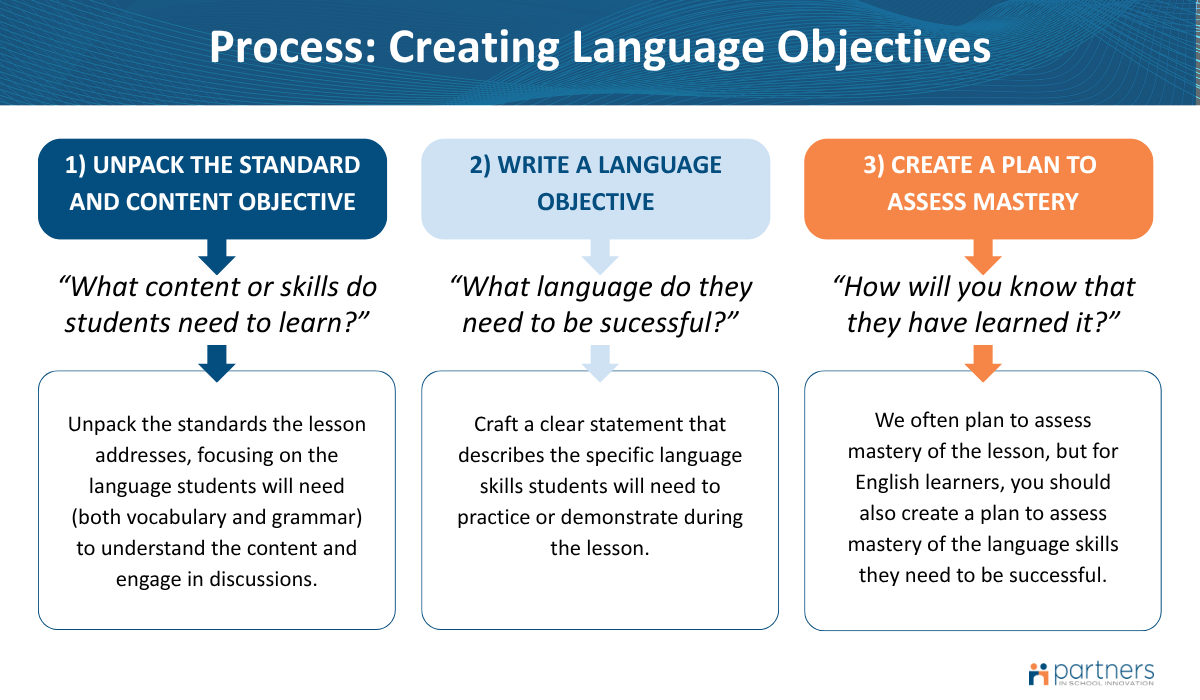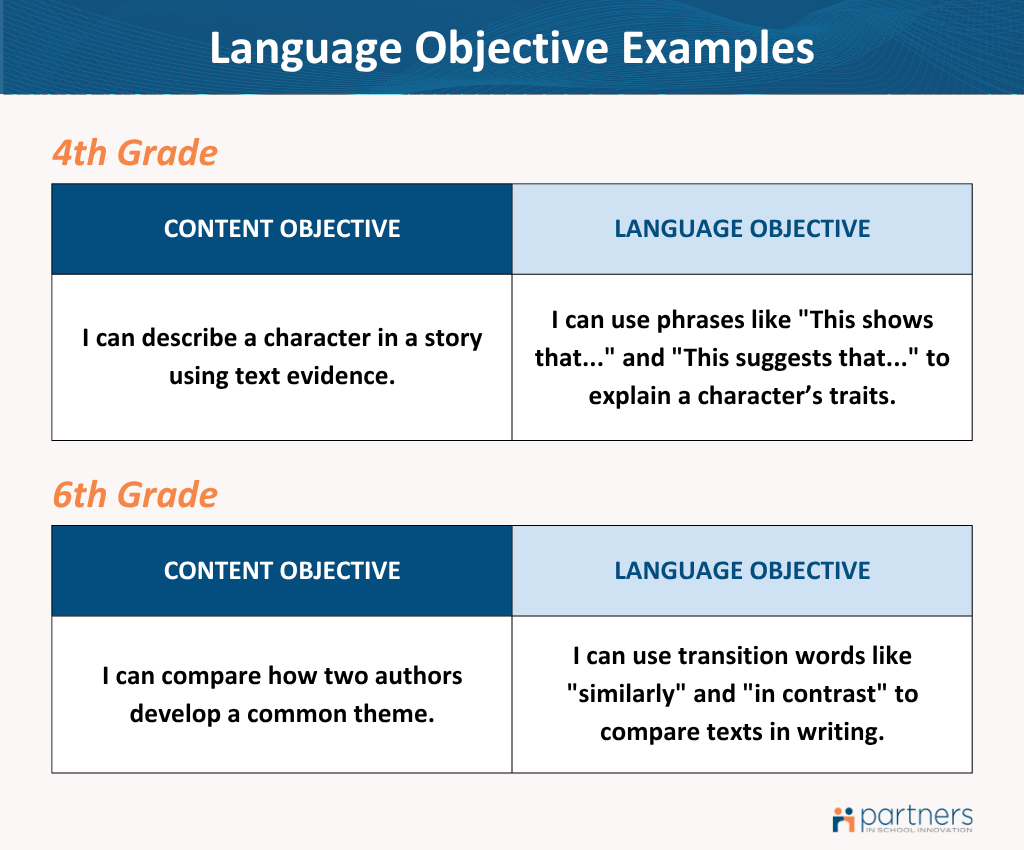How to Create Language Objectives: Strategies for Differentiating Instruction for Multilingual Learners
As educators, we want every student to access meaningful learning experiences. For multilingual learners (MLLs), that means going beyond content instruction to ensure they also develop the academic language skills they need to engage deeply in lessons. As coaches working alongside educators, we’ve seen the power of intentional language instruction in helping multilingual learners (MLLs) fully engage in classroom learning.
Every student walks into a lesson with different language skills, but when we create and implement clear, targeted language objectives, we give them the tools to express their ideas, engage in discussions, and demonstrate what they know.
This article is part of a series on supporting MLLs with differentiated instruction. If you’re new to this series, here’s what we’ve covered so far and what’s coming next:
Understanding and Supporting Multilingual Learners: A Guide to Differentiating Instruction
(You're here!) - How to Create Language Objectives: Strategies for Differentiating Instruction for MLLs
Structured Language Practice: Strategies for Differentiating Instruction for MLLs
In this article, we’ll be sharing how to create language objectives that support MLLs and English Language Learners (ELLs) are developing the academic language skills they need to succeed in the classroom.
Why Language Objectives Are Supportive For Multilingual and English Language Learners
For students to fully engage with a lesson, they need more than just content knowledge, they need the language to access, discuss, and demonstrate their learning. This is especially true for Multilingual Learners (MLLs), who are often expected to explain their thinking, compare ideas, and justify their reasoning in academic language while still developing English proficiency.
Explicit language instruction helps bridge this gap by giving students direct teaching on the words, sentence structures, and discourse patterns they need to participate in class. Without it, they may grasp the content but struggle to communicate their understanding. Research shows that when students get explicit language instruction, they’re better able to grasp concepts and participate more fully in class (Echevarria, Short, & Vogt, 2008).
As an example, take a history lesson on the causes of the American Revolution. The content objective might be for students to understand key events, but to demonstrate their learning, they need to use cause-and-effect language structures, like:
"The Stamp Act led to increased protests because..."
"As a result of British taxation, the colonies..."
If we don't plan to explicitly teach these structures and give students opportunities to practice them, many MLLs will struggle to express their learning, even if they understand the content. That’s where language objectives and explicit language instruction come in. They give students the scaffolding they need to communicate their learning, express their understanding, and participate confidently in discussions.
Three Steps to Writing Strong Language Objectives
Creating effective language objectives is a process. I often walk teachers through these three key steps to ensure objectives are clear, relevant, and actionable.
Image description: An infographic outlining the three steps to creating a language objective. The steps are: 1) Unpack the standard and content objective, 2) Write a language objective, and 3) Create a plan to assess mastery.
1. Unpack the Content Objective
Before writing a language objective, start with the content. Ask yourself:
What are students learning?
What will they need to do with that knowledge?
What language will help them express their understanding?
Let’s say you’re teaching a 4th-grade reading comprehension lesson where students need to describe a character in a story. Your student-facing content objective might be:
"I can describe a character in a story using text evidence."
Now, think about the language skills students need to meet that goal. Do they need to use specific adjectives to describe a character’s personality? Will they need structured sentence stems to support their explanations? Will they need key vocabulary like "traits," "motivations," or "dialogue"?
This step shifts the focus from just what students need to learn to how you can explicitly teach the language they need to express their understanding.
Step 2: Write a Student-Friendly Language Objective
Once you’ve identified the language skills needed, it’s time to turn them into a clear, student-friendly objective. A strong language objective should be:
Easy to understand (“I can...”)
Connected to content learning (so it’s relevant to the lesson)
Specific about language use (what words, structures, or skills students will use)
Measurable (so students and teachers can check progress)
Here’s how that 4th-grade and 6th-grade example might look:
Image description: A graphic titled "Language Objective Examples" shows two grade-level examples pairing content objectives with language objectives. For 4th grade, the content objective is describing a character using text evidence, and the language objective is using phrases like “This shows that…” to explain traits. For 6th grade, the content objective is comparing how two authors develop a theme, and the language objective is using transition words like “similarly” and “in contrast” in writing.
By explicitly naming and modeling the language skills students need, we remove the guesswork so students can focus on learning, not struggling to figure out how to express their ideas.
Step 3: Plan for Language Assessment
Once you’ve introduced a language objective, how do you know if students are actually using it?
Assessing language learning doesn’t have to mean more tests. Some of the best ways to assess language use are built into everyday classroom routines—listening in on student discussions, reviewing their written work, and observing how they apply language during group tasks.
For example, if your objective is for students to use transition words in writing, you might:
Have them highlight transition words in their own writing.
Use sentence stems during discussions to reinforce the skill.
Give students a peer-review checklist to check for language use.
The key to assessment is making sure that students get multiple opportunities to practice and receive feedback. Ask yourself:
Are students using the target vocabulary and sentence structures?
Can they explain the skill in their own words?
Does the lesson give them enough structured practice?
By keeping assessments quick, integrated with the lesson, and meaningful, language learning becomes a natural part of the lesson, not an afterthought.
Putting It into Practice
If you’re new to writing language objectives, start small. Choose one upcoming lesson and think about one language skill students will need. Write a language objective, model it explicitly, and listen for how students use that language in class.
Language instruction works best when it’s explicit, structured, and embedded into content learning. In the next article in this series, we’ll dig into Explicit Vocabulary Instruction, another key strategy for helping MLLs build strong academic language skills.
Need More Support?
If you’re ready to take these steps further, we’re here to help. Our coaches at Partners in School Innovation offer hands-on support for schools and districts committed to creating equitable learning environments for all students, including MLLs and English language learners.
Contact our team to explore how we can support your goals and help you take meaningful steps toward equity.
You can also access more of our professional learning resources:
Join Our Online Community of Educators
Collaborate with over 650 equity-focused education leaders sharing resources, ideas, and inspiration every week. This community connects you with peers navigating the same challenges and trusted leaders dedicated to solving systemic inequities.
Join the online community here.
Explore Online Professional Development Courses for Educators
Our on-demand, self-paced courses are designed by leading experts and focus on equity-driven strategies. These include curated activities, opportunities to practice, and space for reflection.
Popular courses include:
Leading Improvement Cycles
From Root Causes to Grassroots Action
Data for Liberation
Browse the full course catalog here.
Looking for something custom? We also create tailored courses for schools and districts. Let us know if you’d like to develop one designed to meet your unique needs.


